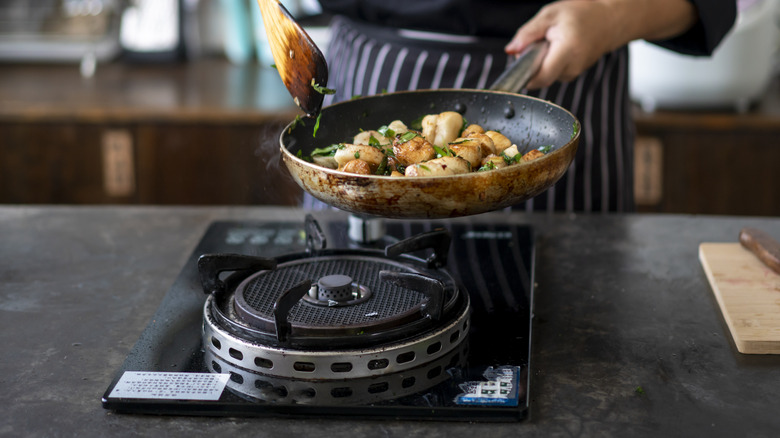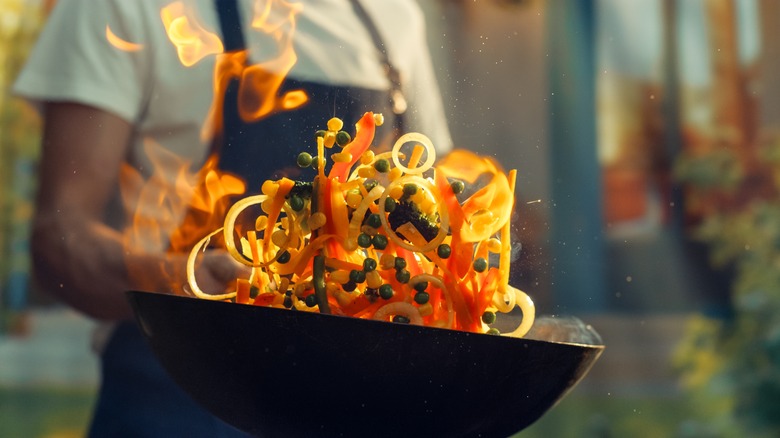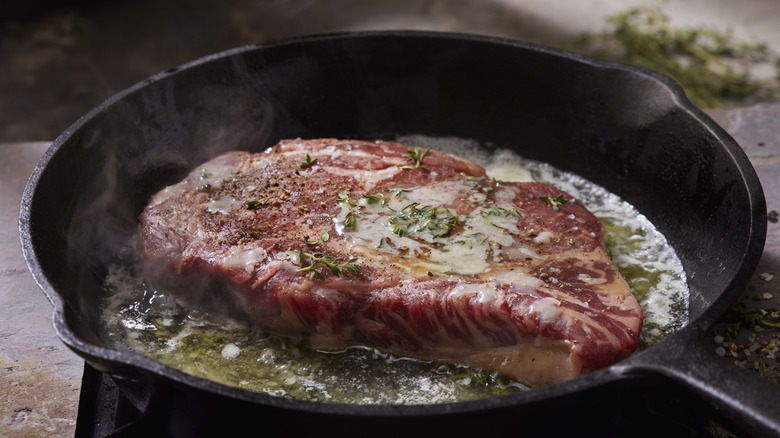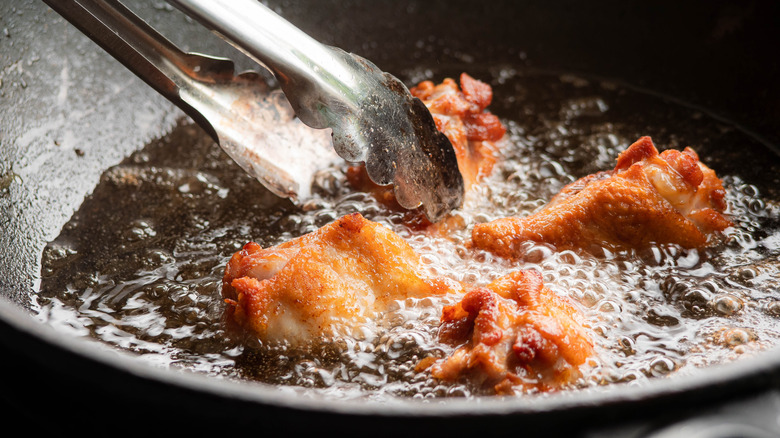Is There Really A Difference Between Sautéing, Searing, And Pan Frying?
Though it may not always seem like it, cooking is a science, and as such it has its fair share of jargon. If you're new to the kitchen, figuring out the difference between a dozen similar-sounding terms can be quite the challenge. For example, it's easy to confuse sautéing, searing, and pan frying since they all take place on the stovetop and require some sort of heat. Despite their surface-level similarities, each of these techniques serves a specific role. Understanding the basics of these methods will help you decide when to use each one, which will elevate your overall cooking skills.
Very basically, sautéing allows you to quickly cook ingredients through, searing brings out deep and savory flavors, and pan-frying creates a crispy texture. All three of these methods use direct heat and a bit of oil, and all work well with a nicely seasoned cast iron pan. However, these techniques cannot be used interchangeably. Each is more suitable for specific ingredients and dishes, which is why it pays to know the difference.
Sautéing is fast and light
If you want to cook up a quick weeknight dinner, perhaps some chopped up chicken and veggies, sautéing is the way to go. Sautéing is all about high heat and movement — the word means "jump" in French, after all. This combination creates evenly cooked food with a nice amount of browning. To properly sauté, first add a small amount of fat to a pan. If you can't decide whether to use butter or oil, Ina Garten's answer to the debate is to go with a bit of both. Once the pan is very hot, toss in your other ingredients, being careful not to overcrowd the pan. Here's where the "jumping" comes in: As soon as the food touches the pan, you should continuously move, shake, and flip everything around so that nothing burns. Professional chefs do this by tossing the food in and out of the pan, but you can just stir everything with a wooden spoon.
Vegetables like bell peppers, mushrooms, and onions are perfect for sautéing, as are light proteins like shrimp or strips of chicken. The high heat cooks food fast and creates a beautiful color. This method is great for a stir-fry or any other quick meal. Just keep a constant eye on the pan so nothing burns, and keep stirring (or flipping) to make sure everything cooks evenly.
Searing creates deep flavor
Unlike sautéing, searing is usually only one part of a multi-step cooking method. In fact, it's even common to sear ingredients before sautéing them. The searing method, also known as pan-searing, is typically used on large cuts of meat in order to give them some extra umph. This happens via the Maillard reaction, which is what gives food like steak a delicious browned finish. There's a misconception that searing "locks in" juices, but this isn't necessarily true. Instead, it simply adds even more flavor to an already scrumptious dish.
A cast-iron skillet is the gold standard for searing, since its ability to retain and distribute heat evenly makes it perfect for high-heat cooking, but some professional chefs swear by stainless steel. To start searing, set your stovetop to high heat and add a small amount of oil. Liberally season whatever you plan on cooking, and let it sear for a couple minutes on each side. Searing is typically used for protein that will be cooked further, such as steak, pork chops, or thick fish filets. However, it's also great for tofu, veggies, or anything that would benefit from a deep, roasted flavor. For the best results, pat food dry before placing it in the pan since excess moisture can prevent browning. To practice your searing skills, try making our herby lemon butter fish skillet recipe.
Pan-frying adds a crispy crust
Pan-frying, or shallow-frying, creates a crispy crust with a tender inside, making it a go-to technique for foods that can use a crunch like fried chicken, scallops, and schnitzel. Start by adding a thin layer of oil (about ¼ inch) to a heavy skillet. Heat the oil over medium to medium-high heat until it bubbles when you dip in a bit of food or flour — that's how you know it's ready. Once the oil is hot, carefully add the food, but don't overcrowd the pan or it may lower the temperature of the oil. Cook for a few minutes on each side until you're left with a golden brown surface.
Foods like breaded chicken cutlets or fish, pork chops, and even sturdy vegetables such as carrots and asparagus work well for pan-frying. These ingredients are strong enough to keep their structure even after being cooked, and taste even better with a delicate, crunchy exterior.
Mastering different cooking methods may sound daunting, but being able to know exactly how to best prepare various ingredients will be worth it. Keep practicing and exploring the different benefits sautéing, searing, and pan-frying have to offer, and soon you'll be cooking with complete control.



